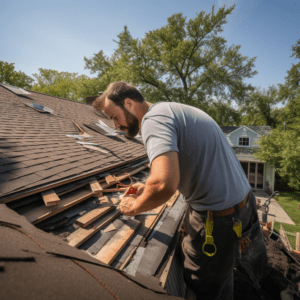In considering the need for durable roof replacements, one might argue that the expense and effort required outweigh the benefits. However, it is crucial to recognize that investing in a long-lasting roofing system can provide numerous advantages. This article aims to explore the benefits of durable roof replacements, discuss various types of resilient roofing materials, highlight factors to consider for longevity, provide steps for successful replacement processes, identify signs indicating the need for replacement, examine how weather resistance affects durability, offer maintenance tips to extend lifespan, and emphasize the importance of hiring professionals for reliable replacements.
Key Takeaways
- Durable roof replacements can withstand harsh weather conditions and reduce the need for frequent repairs and maintenance.
- Different roofing materials offer varying levels of durability, with concrete tiles, metal sheets, and slate being popular options.
- Professional installation and understanding maintenance requirements are crucial for ensuring the longevity and effectiveness of the roof replacement.
- Hiring reputable contractors is important as they have extensive experience, knowledge, and use high-quality materials, while also providing warranties for their services.
Benefits of Durable Roof Replacements
One of the benefits of durable roof replacements is their ability to withstand harsh weather conditions, reducing the need for frequent repairs and maintenance. A durable roof replacement can provide significant advantages in terms of longevity and cost-effectiveness. By installing a durable roof, homeowners can ensure that their property remains protected against various weather elements such as heavy rain, strong winds, snowfall, hailstorms, and extreme temperatures.
Durable roof replacements are typically made from high-quality materials that offer enhanced resistance and durability. For instance, metal roofs are known for their strength and ability to withstand severe weather conditions. They are resistant to fire, rotting, insect damage, and cracking. Similarly, asphalt shingles with higher ratings are designed to endure intense heat and UV radiation without deteriorating quickly.
With a durable roof replacement in place, homeowners can avoid frequent repairs and maintenance expenses. Traditional roofing materials may require regular inspections or repairs due to wear and tear caused by adverse weather events. However, durable roofs have a longer lifespan due to their superior quality construction and improved resistance to environmental factors.
Furthermore, these roofs often come with warranties that cover defects or damages for an extended period. This warranty provides financial protection against unexpected repair costs during the warranty period.
Types of Durable Roofing Materials
Concrete tiles, metal sheets, and slate are among the various roofing materials that offer long-lasting protection against environmental elements. Concrete tiles are known for their durability and resistance to fire, wind, and hail damage. They are typically made from a mixture of cement, sand, and water which is molded into shape and then cured to achieve strength. Metal sheets, such as steel or aluminum panels, provide excellent longevity due to their corrosion resistance and ability to withstand severe weather conditions. These sheets are often installed in large sections with interlocking seams to ensure a watertight seal. Slate is a natural stone material that offers exceptional durability and aesthetic appeal. It is formed from layers of fine-grained rock that have been compressed over time. Slate roofs can last for over a century when properly maintained. In addition to their durability, these roofing materials also offer other advantages such as energy efficiency (in the case of metal) or natural insulation properties (in the case of slate). Overall, choosing one of these durable roofing materials ensures long-term protection for your home against environmental factors while maintaining an attractive appearance.
Factors to Consider for Long-Lasting Roof Replacements
This discussion will focus on key factors to consider for long-lasting roof replacements, including material lifespan comparison, professional installation importance, and maintenance requirements and costs. Comparing the lifespan of different roofing materials is crucial in making an informed decision about which option will provide the longest-lasting solution. Additionally, professional installation plays a vital role in ensuring the longevity and effectiveness of a roof replacement. Finally, understanding the maintenance requirements and associated costs can help homeowners plan for ongoing care and potential expenses over time. By examining these factors thoroughly, individuals can make informed decisions regarding their roof replacements to ensure durability and longevity.
Material Lifespan Comparison
When comparing the lifespans of different roofing materials, it is important to consider their durability and resistance to environmental factors. Asphalt shingles are one of the most commonly used roofing materials due to their affordability and ease of installation. However, they have a relatively shorter lifespan compared to other materials, typically lasting between 15 to 30 years. Metal roofs offer superior durability and can last up to 50 years or more with proper maintenance. They are resistant to fire, wind, and hail damage. Slate roofs are known for their exceptional longevity, often lasting over a century when properly maintained. However, they require expert installation due to their weight and fragility. In comparison, clay tile roofs also have a long lifespan of around 50 years or more but may crack under extreme weather conditions. Ultimately, choosing the right roofing material depends on various factors such as budget, climate, and desired aesthetics.
Professional Installation Importance
Professional installation is crucial for ensuring the longevity and effectiveness of roofing materials, as it guarantees proper installation techniques and adherence to manufacturer guidelines. When roofing materials are not installed correctly, they may be more prone to damage from environmental factors such as wind, rain, or snow. Professional installers have the necessary knowledge and experience to properly handle and install various types of roofing materials. They are aware of the specific requirements recommended by manufacturers for each material, including proper sealing, flashing installation, and ventilation methods. Additionally, professional installers use specialized tools and equipment that ensure precise measurements and secure installations. By hiring professionals for roof installations, homeowners can have peace of mind knowing that their roof will be properly installed in accordance with industry standards and manufacturer recommendations.
Maintenance Requirements and Costs
The regular maintenance and associated costs of a roofing system are essential factors to consider for homeowners. Proper maintenance is crucial to ensure the longevity and functionality of the roof. Regular inspections should be conducted to identify any signs of damage or deterioration, such as loose or missing shingles, leaks, or clogged gutters. Prompt repairs should be carried out to prevent further damage and avoid costly replacements. Additionally, routine cleaning is necessary to remove debris and prevent the growth of moss or algae which can compromise the roof’s integrity. Homeowners should also budget for regular maintenance costs, including professional inspections and repairs, gutter cleaning services, and occasional replacement of damaged components. By investing in regular maintenance, homeowners can extend the lifespan of their roofs and minimize long-term expenditures.
Steps to Ensure a Successful Roof Replacement
This discussion focuses on three key points to ensure a successful roof replacement: hiring reputable roofing contractors, choosing quality materials, and proper roof maintenance. When it comes to hiring contractors, it is important to conduct thorough research and consider their reputation, experience, and certifications. Additionally, selecting high-quality materials for the replacement will contribute to the longevity and durability of the new roof. Finally, implementing a regular maintenance routine will help prevent issues such as leaks or damage in the future.
Hiring Reputable Roofing Contractors
To ensure high-quality and long-lasting roof replacements, it is essential to carefully select reputable roofing contractors. Hiring the right contractor significantly impacts the success of a roof replacement project. Reputable contractors possess extensive experience and knowledge in the field, ensuring that they can handle any type of roofing job efficiently. They are well-versed in local building codes and regulations, guaranteeing that the replacement is done in compliance with industry standards. Moreover, reputable contractors use high-quality materials and employ skilled workers who are trained to deliver exceptional workmanship. They also provide warranties for their services, giving homeowners peace of mind knowing that any issues arising from the replacement will be addressed promptly. By hiring reputable roofing contractors, homeowners can be confident that their roof replacements will be completed successfully and will withstand the test of time.
Choosing Quality Materials
Choosing quality materials for a roof replacement project involves considering factors such as durability, resistance to weather elements, and compatibility with the existing structure. When it comes to durability, materials like metal, clay or concrete tiles, and slate stand out as excellent choices. These materials can withstand harsh weather conditions such as heavy rain, strong winds, and extreme temperatures. They are also resistant to fire and impact damage. Additionally, they have a longer lifespan compared to other roofing materials. In terms of weather resistance, asphalt shingles are popular due to their ability to withstand water penetration and UV rays. Lastly, compatibility with the existing structure is crucial for a successful replacement project. It is essential to choose materials that can be properly installed on the current framework without compromising its integrity or stability.
Proper Roof Maintenance
Proper roof maintenance is essential for ensuring the longevity and durability of a roof replacement. Regular inspections should be carried out to identify any signs of damage or wear, such as cracked or missing shingles, sagging areas, or leaks. Prompt repairs should be made to prevent further deterioration and potential structural issues. Additionally, keeping the roof clean by removing debris, leaves, and moss can help prevent water pooling and reduce the risk of moisture-related problems.
Regular gutter cleaning is also crucial as clogged gutters can lead to water overflow and damage to the roof and its underlying structure. Furthermore, trimming overhanging branches can minimize the risk of falling debris during storms or high winds.
Following manufacturer guidelines for maintenance tasks such as cleaning methods, frequency, and recommended products will ensure that proper techniques are used without causing any harm to the roofing materials. By implementing these maintenance practices, homeowners can extend the lifespan of their roof replacements and avoid costly repairs in the future.
Signs It’s Time for a Durable Roof Replacement
Indicators of the need for a durable roof replacement can be identified through an assessment of various signs. One such sign is visible damage to the roof, such as missing shingles, cracked tiles, or sagging sections. These issues not only compromise the aesthetic appeal of the roof but also expose it to further damage from water infiltration and structural instability. Another indicator is recurring leaks in the ceiling or attic after heavy rainfall. This suggests that the roofing materials have deteriorated to a point where they are no longer providing adequate protection against moisture penetration.
Additionally, excessive granule loss from asphalt shingles may indicate the need for a replacement. Granules play a crucial role in protecting the underlying layers of shingles from harmful ultraviolet (UV) radiation and heat absorption. If they become dislodged or worn out, the shingles become vulnerable to UV degradation and premature aging.
Furthermore, if a roof has reached its expected lifespan, which varies depending on material type and quality, it may be time for a replacement even if there are no apparent signs of damage. For example, asphalt shingle roofs typically last around 20-30 years before they require replacement.
How Weather Resistance Impacts Roof Replacement Durability
Weather resistance is a critical factor that influences the durability of roof replacements. Extreme weather conditions, such as heavy rain, strong winds, and intense heat, can significantly impact the longevity of a roof.
Rainwater is one of the main culprits behind roof damage. A durable roof replacement should be able to effectively channel and drain water away from the structure to prevent leaks and water damage. Additionally, strong winds can cause shingles or other roofing materials to lift or detach from the roof deck, leading to potential structural issues if not addressed promptly.
Another important consideration is the impact of intense heat on a roof’s durability. Excessive heat can cause roofing materials to deteriorate more rapidly over time, leading to cracks, warping, or even complete failure.
To ensure maximum weather resistance in a new roof replacement, it is crucial to select high-quality materials specifically designed for your climate. Materials like metal or tile are often preferred for their ability to withstand harsh weather conditions.
Furthermore, proper installation techniques play an essential role in enhancing weather resistance. Engaging professional roofing contractors who are experienced with ensuring adequate sealing and ventilation will contribute to a more durable roof replacement.
Maintenance Tips for Extending the Lifespan of Your New Roof
Regular maintenance and inspections are essential for prolonging the lifespan of a newly installed roof. By following a few practical tips, homeowners can ensure that their roofs remain in optimal condition and continue to protect their homes for years to come.
Firstly, it is important to regularly clean the gutters and downspouts. Clogged gutters can lead to water pooling on the roof, causing damage over time. Additionally, removing any debris or leaves will prevent blockages and potential water damage.
Secondly, homeowners should inspect their roofs twice a year, preferably in spring and fall. During these inspections, they should look for signs of wear and tear such as cracked or missing shingles, loose flashing, or damaged seals around vents and chimneys. Identifying these issues early can prevent further damage and costly repairs.
Furthermore, maintaining proper attic ventilation is crucial for preserving the integrity of the roof. Inadequate ventilation can lead to excessive heat buildup in summer months and moisture accumulation during colder seasons. This can result in premature deterioration of roofing materials.
Lastly, it is advisable to hire professional roofing contractors for regular inspections and maintenance tasks. Their expertise ensures comprehensive evaluations of the roof’s condition while minimizing any potential safety risks associated with DIY efforts.
Hiring Professionals for Reliable Roof Replacements
Contracting experienced professionals for the replacement of your old roof ensures a reliable and proficient execution of the task. When it comes to replacing your roof, it is essential to hire professionals who have the necessary expertise and knowledge in this field. Experienced roofing contractors possess the skills required to handle various types of roofing materials, ensuring that the installation process is done correctly.
One advantage of hiring professionals for roof replacements is their ability to assess the condition of your existing roof accurately. They can identify any underlying issues that may not be apparent to an untrained eye, such as structural damage or leaks. This thorough evaluation enables them to develop a comprehensive plan for replacing your old roof effectively.
Additionally, professional roofers are equipped with the appropriate tools and equipment needed for a successful replacement project. They are familiar with safety protocols and adhere to industry standards during installation, minimizing potential risks or accidents on-site.
Moreover, experienced professionals have access to high-quality materials and can recommend suitable options based on your budget and preferences. They can provide guidance on choosing durable roofing materials that withstand weather conditions prevalent in your area.




